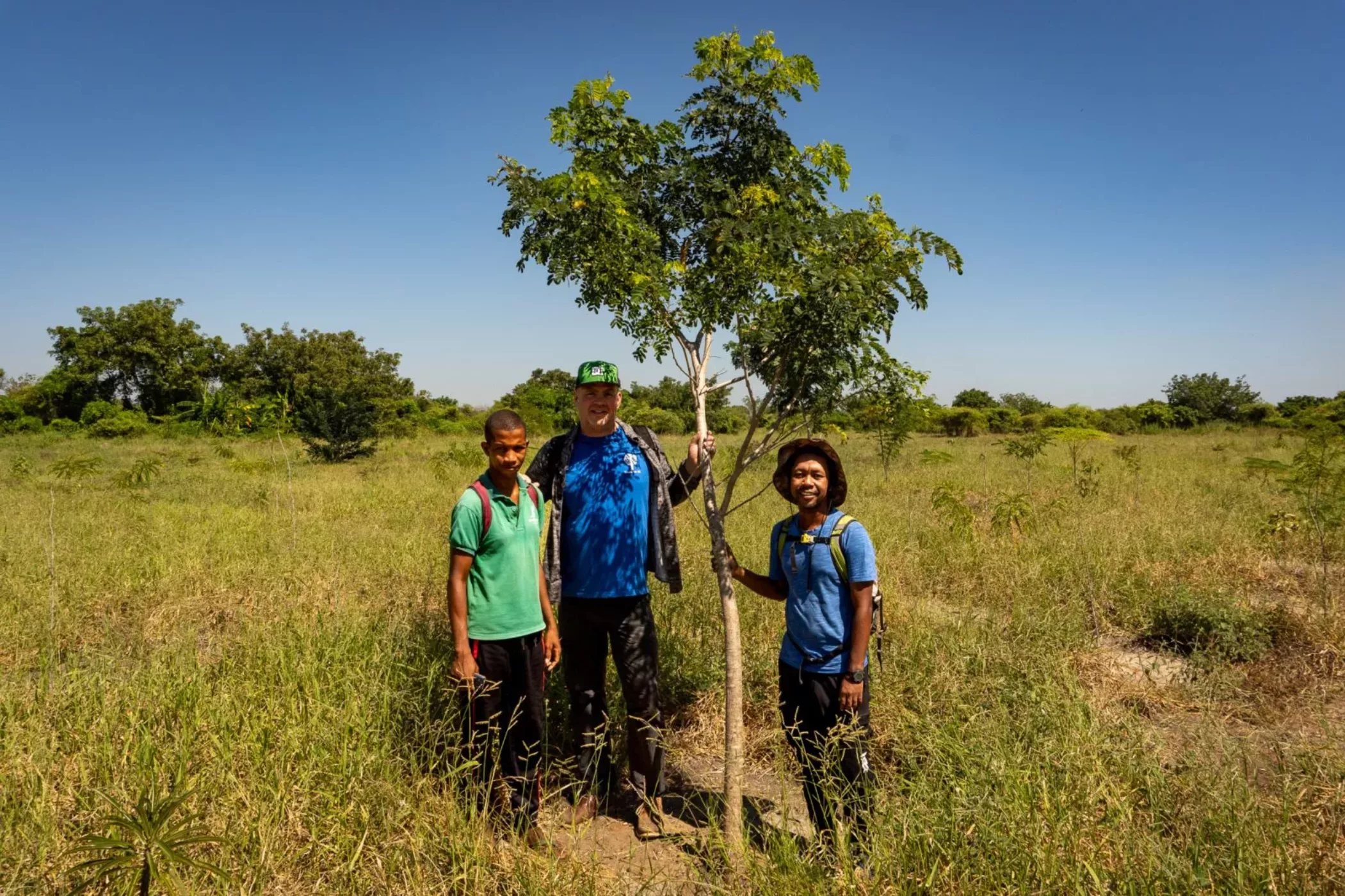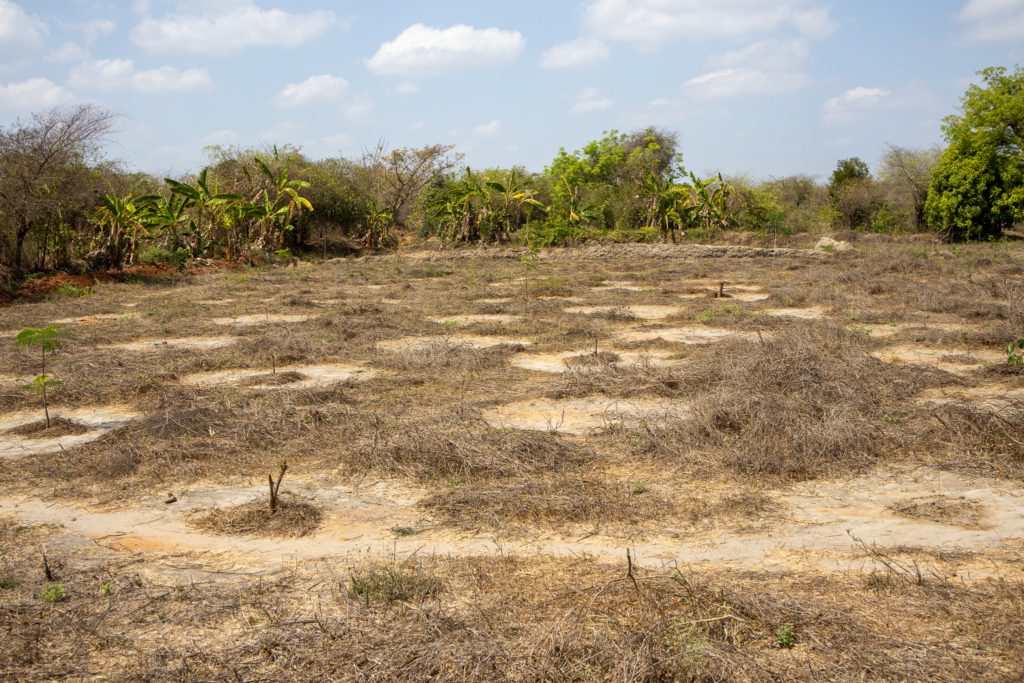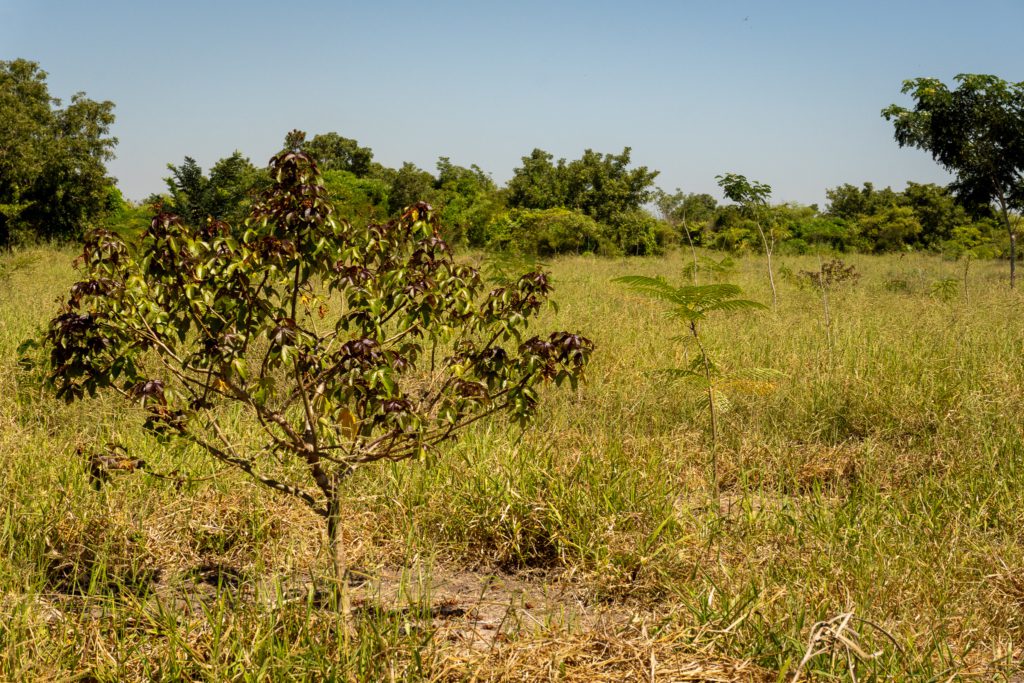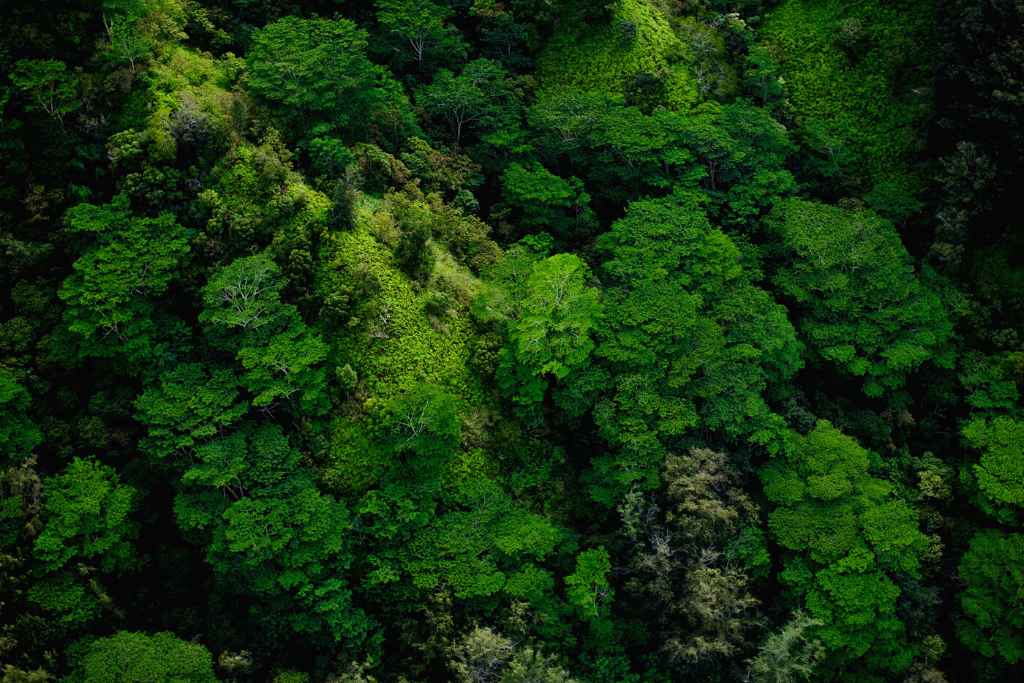A glimmer of hope: we visited our reforestation project in Madagaskar
22 May 2024

22 May 2024
Giant baobab trees, dozens of species of lemurs and colourful chameleons. To preserve this unique biodiversity in Western Madagascar, it is badly needed to protect as well as restore the forests. Trees for All therefore supports Zazamalala’s challenging reforestation project. A total of 150,000 trees have been planted around one of the last forests in the region. And that is not easy, but during our project visit we saw that together we can make a difference.
It is the end of the rainy season. As we travel to our project area, the view startles us. Where recently there was beautiful green forest, we find kilometres of bare and degraded land. And lots of small-scale agriculture. But forest is nowhere to be seen anymore.
As much as 97% of the original ‘dry forest’ in Western Madagascar has disappeared. This major deforestation is due to increasing population growth and to ‘slash & burn’, in which forest is cut down and set on fire. This clears land to grow rice, maize and cassava. In addition, forest is rapidly being cut down for charcoal for cooking.
Large-scale forest clearing has made it one of the most endangered ecosystems in the world. This is disastrous because these forests and many animal and plant species are only found in Madagascar. Moreover, if we do nothing, the local population will be left behind in a dry and arid desert.
That is why Trees for All has been supporting the reforestation project of the Zazamalala Foundation since 2021. Arriving at the project near the town of Morondava, we do not know what we see: a tiny green oasis in the middle of the barren landscape.
The Zazamalala forest of +-/ 24 years old
Simon Rietveld, founder and our project partner, has been committed to protecting forests and all the species that depend on them since 2000. And with success. His botanical garden is home to dozens of Malagasy plant and tree species. In addition, Simon has bought up 70-80 hectares of former rice and cassava fields and reforested them. He named the piece of land ‘Zazamalala’, meaning sweet child.
After 24 years, the Zazamalala forest is bursting with life. During our visit, we saw beautiful chameleons, intensely large spiders and at night we stumbled across snakes and scorpions. Simon also gives shelter to lemurs and sifakas in the forest.
Thanks to donations we receive as Trees for All, we help Zazamalala preserve and further expand its forest. So far, together we have already reforested about 150 additional hectares! That means a larger habitat and more food for the rare animals and plants that are on the verge of extinction.
During our visited we spotted the Southern carpet chameleon (Furcifer major), white herons, Verreaux’s sifaka and lemurs in and around the Zazamalala forest
Monsieur Fety, in charge of reforestation, took us into the field to look at ‘our trees’. With a degree in Forest & Nature Conservation, he has a lot of knowledge and is super motivated to make a success of the project. ‘Because nature doesn’t need man, but man needs nature,’ he said.
To get to the planting sites, we ploughed through prickly, invasive grass and soggy paddy fields. Wet feet are part of the job. With no shade in the open field, it was bloody hot (at least 40 degrees) and the sweat dripped off us. But then you have something: how happy we were to see one of our little trees at the foot of a giant baobab!
In the different plots, we checked how the trees are growing
We are impressed with the results of the Zazamalala project. Most of the young trees are doing well within three years they are already about three metres tall. One of the trees is already that big in four months! That bodes well.
To achieve the reforestation, Zazamalala uses a clever planting method. First, fast-growing local tree species are planted to provide shade. This keeps grass away and soon the little trees peep out above. A circle around the tree saplings is also kept clear of grass or weeds so they don’t get overgrown.
Some of the seedlings we found were struggling in the heat. To make sure they don’t dry out, straw or mulch is placed around the sapling.


The saplings we plant come from Zazamalala’s own nursery. Nearly 100 different indigenous tree species are grown there. These include ebony, palm and mahogany trees. And, of course, the imposing Grandidier Baobab, which is so characteristic of this region.
Some rare species are even on the IUCN Red List of Threatened Species. Simon is determined to save these species from extinction. And planting so many different species creates a diverse and resilient forest.
Madame Marie Concepcion, a herpetologist, is in charge of the nursery and looks after the animals. In her first month on duty, she found two species of blind snakes that she had not seen here before. And that is what Simon likes best about Zazamalala: that they contribute to knowledge about Madagascar’s unique flora and fauna.
Madame Marie Concepcion, Luciana and other staff members in the nursery
The Zazamalala forest cannot be taken for granted and the project has many challenges. Besides the problem of ‘slash and burn’, the pressure on the existing forest is high due to climate refugees from the south. The transition to sustainable land use is also extremely difficult. More forest is disappearing every day.
And the less forest, the more extreme the heat becomes. And that in turn leads to poor harvests in a region already rife with poverty and hunger. A vicious circle that is hard to break.
But the Zazamalala project shows it can be done differently. Monsieur Fety: ‘The forest is good for everyone. The trees provide more rain, clean air and shade.’ In fact, the trees we plant create a better microclimate with more rainfall. They also retain rainwater in the soil so it becomes fertile again. Thus, we turn degraded land back into vibrant forest.
The project not only provides a more stable environment but also generates employment. Zazamalala employs 40 people from the surrounding villages on a permanent basis. Men mainly do the heavy work: they clear the plots of weeds, dig holes and plant the trees. Women work in the nursery. They fill bags with compost and soil and tend the seedlings. This allows them to support their families.
Despite the difficult conditions, several organisations are doing all they can to protect and restore the forests in western Madagascar. Soary Randrianjafizanaka, regional director at the Malagasy NGO Fanamby, took us to the Allée des Baobab, one of Madagascar’s most famous spots.
These magnificent baobab trees are called ‘Reniala’ in the Malagasy language, ‘mother of the forest’. Now these giant trees are a silent witness to deforestation: the only ones spared from forest fires and logging. A beautiful and sad sight, as previously the baobabs were in a dense forest.
Fanamby manages the two nature reserves Allée des Boabab and the Andranomena Reserve in the region. Within those reserves, they also restore burnt areas. Thanks to their efforts, there has been 73% less deforestation in recent years. And they are replanting baobabs, which will hopefully grow as old as their ancestors.
In an effort to ease pressure on the forest, Fanamby is coming up with sustainable alternatives. For example, they encourage eco-tourism and introduce sustainable farming methods to communities.
Visitng Fanamby’s project areas: Allée des Baobabs & Menabe Antimena
In the fishing village of Belo-sur-Mer, we spoke to Hamil Harrison, founder of the Malagasy NGO Dry Forest. Their nursery is next to a primary school, where they also give eco-lessons to pupils. When the trees are big enough, they will be planted in Kirindy Mitea National Park.
‘My biggest dream is that in the future my children will be able to see animals in the forest again and enjoy Madagascar’s unique nature,’ Hamil tells us.
In addition to reforestation, Dry Forest helps local communities with income from sustainable forest by-products, such as baobab fruit powder. Thus, more and more people are becoming aware of the value of forest.
At Dry Forest’s nursery
The project visit was incredibly useful to better understand the situation in Western Madagascar. And to see how different organisations are putting their heart and soul into protecting nature. It was also a great opportunity to think about a long-term approach with our project partner. After all, our reforestation projects are not about planting a tree, but growing a forest.
There is still a long way to go, but the Zazamalala, Fanamby and Dry Forest projects are great examples that with drive, the right people and hard work, reforestation in Western Madagascar really is possible. That gives us hope: that together with our donors we are actually contributing to the protection and restoration of Madagascar’s unique biodiversity.

Would you like to see Trees for All support more projects towards a better climate? Donate a tree and contribute directly to a green and healthy earth.
Plant a tree